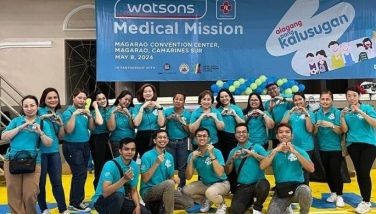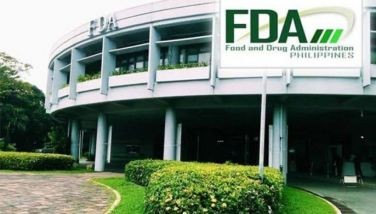‘Crab mentality’ takes a positive turn
May 9, 2004 | 12:00am
Crab mentality. This phrase conjures images of unfriendly competition, backbiting, jostling and trampling of each other in a race towards a common goal.
For many fisherfolk associations (FAs) and cooperatives, this "crab mentality" has become an agent of change and development, a catalyst for cooperation, unity and teamwork, all towards a common goal – greater income for each member’s family.
Minimizing capture fishery, lessening pressure to the sea.
Actually, and only for this particular story, the phrase, "crab mentality" is known as aquasilviculture. Simply put, the technology is pen culture of mudcrabs in mangrove areas. What used to be idle mangrove areas can now be turned into economically productive sites without disturbing their natural ecological state.
Aquasilviculture was introduced to selected coastal communities nationwide by the Bureau of Fisheries and Aquatic Resources (BFAR) through the Fisheries Resource Management Project (FRMP). FRMP is a six-year undertaking of DA-BFAR with the two-pronged objective of reversing the trend in fishery resource depletion and in alleviating the widespread poverty among the country’s subsistence fishers. The technology is one livelihood alternative being promoted by FRMP to temporarily wean municipal fishers from capture fishing to lessen pressure on coastal resources. The technology is seen to prevent them from practicing illegal fishing and from using fishing gears that are harmful to coastal resources.
To the subsistence fishers of Napti, a coastal barangay in Batan, Aklan, this new crab mentality is gaining momentum. The mudcrab project is located in a mangrove area on an islet near the mouth of the town’s river that drains into Sapian Bay. A total of 2,000 crablets have been stocked in enclosed pens in January 2004. The islet is enclosed with a bamboo fence festooned with nets to keep the crablets in. Plastic is wound on the upper portion of the net to discourage them from escaping the pen.
The venture is operated by the Napti Small Fisherfolk Multi-purpose Cooperative (NAMPC) with technical assistance from BFAR-FRMP under its income diversification component. The other livelihood project is mangrove nursery establishment and management.
According to its president, Reynaldo Matias, who is also the barangay chairman, and radio operator for the local Fishery Law Enforcement Team (FLET), the crablets are fattened with trash fish and green mussels until they reach maturity at 4 to 6 months. Harvesting is done in batches as they grow to marketable sizes of 250 to 500 gram per or when their carapaces measure 12 to 15 cm.
Total project cost for this size of operation is about P35,000, according to FRMP Technical Coordinator for Region 6 Manuel Dimalaluan. This investment covers cost of materials for the pen such as nets, bamboos and plastic, for purchase of crablets for seeding and for operational cost such as feeding and maintenance.
At 86 percent survival rate at maturity, the expected total average weight yield during harvest is 473 kilograms at 3 to 4 pieces per kilo depending on weight that range from 250 to 500 gram per piece. And at present prevailing prices ranging from P150 to P250/kg, total sales is estimated at P80,000.
Minus expenditures for materials, crablets and feeds, the organization expects a net profit of about P35,000 or an ROI of 72 to 74 percent, Dimalaluan added.
Harvesting is done manually at low tide. The crabs are sold to a local buying station or to a local trader who regularly comes to the village.
The NAMPC was earlier organized by the PAKISAMA, an NGO, but which had been inactive until FRMP was introduced. The cooperative was reactivated and strengthened by PHILLDRA-USWAG, the FRMP contracted-NGO in Sapian Bay. The NMPC has 36 members.
Because of the high demand of crabs in the market, the technology is gaining popularity along Sapian Bay. Besides NAMPC, the Camansi Small Fisherfolk Association in the neighboring barangay in Batan, is also engaged in aquasilviculture.
Likewise with the Brgy. Cabugao Small Fisherfolk Association (CSFA) in the adjacent town of Ivisan and Brgy. Maninang Small Fisherfolk Association (MSFA) in the town of Sapian is now into this new economic venture. Both towns are located in the neighboring province of Capiz, also along Sapian Bay.
To former BFARMC chairperson Annabel Bacinillo, the women members took active part in the construction of the pen, from hauling of bamboo poles to splitting and cutting them to erecting the fences around the pen. They also alternate with the menfolk in the feeding of the crablets. They are on standby for the harvest.
The fisherfolk cooperatives and associations mentioned above have an estimated combined membership of over a hundred. At the average Filipino family size of five, the technology benefits more than five hundred fisherfolk in the four barangays alone. FRMP covers a total of 15 barangays in the three municipalities mentioned along Sapian Bay.
In Puerto Princesa City, the cooperative in Brgy. Bacungan could hardly cope with market demand for its mudcrabs in this prime tourist destination. The same trend is observed in Region 8. The region is known as the premier supplier of crablets for pen culture in the country.
For many fisherfolk associations (FAs) and cooperatives, this "crab mentality" has become an agent of change and development, a catalyst for cooperation, unity and teamwork, all towards a common goal – greater income for each member’s family.
Minimizing capture fishery, lessening pressure to the sea.
Actually, and only for this particular story, the phrase, "crab mentality" is known as aquasilviculture. Simply put, the technology is pen culture of mudcrabs in mangrove areas. What used to be idle mangrove areas can now be turned into economically productive sites without disturbing their natural ecological state.
Aquasilviculture was introduced to selected coastal communities nationwide by the Bureau of Fisheries and Aquatic Resources (BFAR) through the Fisheries Resource Management Project (FRMP). FRMP is a six-year undertaking of DA-BFAR with the two-pronged objective of reversing the trend in fishery resource depletion and in alleviating the widespread poverty among the country’s subsistence fishers. The technology is one livelihood alternative being promoted by FRMP to temporarily wean municipal fishers from capture fishing to lessen pressure on coastal resources. The technology is seen to prevent them from practicing illegal fishing and from using fishing gears that are harmful to coastal resources.
The venture is operated by the Napti Small Fisherfolk Multi-purpose Cooperative (NAMPC) with technical assistance from BFAR-FRMP under its income diversification component. The other livelihood project is mangrove nursery establishment and management.
According to its president, Reynaldo Matias, who is also the barangay chairman, and radio operator for the local Fishery Law Enforcement Team (FLET), the crablets are fattened with trash fish and green mussels until they reach maturity at 4 to 6 months. Harvesting is done in batches as they grow to marketable sizes of 250 to 500 gram per or when their carapaces measure 12 to 15 cm.
Total project cost for this size of operation is about P35,000, according to FRMP Technical Coordinator for Region 6 Manuel Dimalaluan. This investment covers cost of materials for the pen such as nets, bamboos and plastic, for purchase of crablets for seeding and for operational cost such as feeding and maintenance.
At 86 percent survival rate at maturity, the expected total average weight yield during harvest is 473 kilograms at 3 to 4 pieces per kilo depending on weight that range from 250 to 500 gram per piece. And at present prevailing prices ranging from P150 to P250/kg, total sales is estimated at P80,000.
Minus expenditures for materials, crablets and feeds, the organization expects a net profit of about P35,000 or an ROI of 72 to 74 percent, Dimalaluan added.
Harvesting is done manually at low tide. The crabs are sold to a local buying station or to a local trader who regularly comes to the village.
The NAMPC was earlier organized by the PAKISAMA, an NGO, but which had been inactive until FRMP was introduced. The cooperative was reactivated and strengthened by PHILLDRA-USWAG, the FRMP contracted-NGO in Sapian Bay. The NMPC has 36 members.
Likewise with the Brgy. Cabugao Small Fisherfolk Association (CSFA) in the adjacent town of Ivisan and Brgy. Maninang Small Fisherfolk Association (MSFA) in the town of Sapian is now into this new economic venture. Both towns are located in the neighboring province of Capiz, also along Sapian Bay.
To former BFARMC chairperson Annabel Bacinillo, the women members took active part in the construction of the pen, from hauling of bamboo poles to splitting and cutting them to erecting the fences around the pen. They also alternate with the menfolk in the feeding of the crablets. They are on standby for the harvest.
The fisherfolk cooperatives and associations mentioned above have an estimated combined membership of over a hundred. At the average Filipino family size of five, the technology benefits more than five hundred fisherfolk in the four barangays alone. FRMP covers a total of 15 barangays in the three municipalities mentioned along Sapian Bay.
In Puerto Princesa City, the cooperative in Brgy. Bacungan could hardly cope with market demand for its mudcrabs in this prime tourist destination. The same trend is observed in Region 8. The region is known as the premier supplier of crablets for pen culture in the country.
BrandSpace Articles
<
>
- Latest
Latest
Latest
March 4, 2024 - 3:32pm
By Ian Laqui | March 4, 2024 - 3:32pm
March 4, 2024 - 2:12pm
By Kristine Daguno-Bersamina | March 4, 2024 - 2:12pm
February 17, 2024 - 2:31pm
February 17, 2024 - 2:31pm
February 13, 2024 - 7:24pm
By Gaea Katreena Cabico | February 13, 2024 - 7:24pm
February 13, 2024 - 7:17pm
By Ian Laqui | February 13, 2024 - 7:17pm
Recommended

























